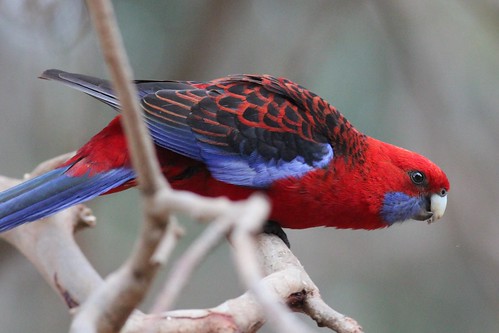 Platycercus elegans melanoptera (Kangaroo Island Crimson Rosella). Image by Arthur ChapmanThe iconic colours in one of one of Australia’s most loved backyard parrots may be the surprise result of a tiny virus that kills other species, new Deakin University research has found.
Platycercus elegans melanoptera (Kangaroo Island Crimson Rosella). Image by Arthur ChapmanThe iconic colours in one of one of Australia’s most loved backyard parrots may be the surprise result of a tiny virus that kills other species, new Deakin University research has found.
A team from Deakin’s Centre for Integrative Ecology (CIE) and the School of Medicine spent eight years studying the Crimson Rosella and its subspecies across NSW, Victoria and South Australia, watching the birds evade the grips of a viral disease that is deadly in other parrot species.
The research team’s results, published this month in prestigious journal Proceedings of the National Academy of Science USA, have important implications for managing disease in Australia’s unique fauna.
Deakin CIE PhD student Justin Eastwood, who did much of the work on the research project, said the results also provided fundamental insights into how new species formed.
“Despite its name, the Crimson Rosella is perhaps Australia’s most colour variable bird and the cause of its striking and beautiful diversity has long fascinated scientists, Mr Eastwood said.
“I was surprised to find that the variety of extraordinary colours in the Crimson Rosella appears to be linked to something known as Beak and Feather Disease Virus, which can be fatal in other species.
“As Ebola and the common cold remind us, disease is ever present and animals and humans have exquisite adaptations and solutions to escape them – and what works for one species, or subspecies, will not necessarily work for another.
“The virus is only found in parrots; it’s no danger to humans, but the danger it presents to parrots seems to vary from species to species and it can be pretty nasty.
“The Australian Government lists the virus as a key threat to biodiversity under the Environment Protection and Biodiversity Conservation Act 1999 as in some species it can lead to extensive feather loss and death.
Another project author, CIE researcher Dr Mathew Berg, said the virus challenged wildlife monitoring and captive breeding programs, particularly with respect to the Orange-bellied Parrot.
“The virus is also of global conservation concern and while it may be confined to parrots, around 25 per cent of the world’s approximately 350 species have been estimated at risk of global extinction,” Dr Berg said.
“Our research results are not only good news for Crimson Rosellas, but we now have a good model species with which to study the disease, which is extremely important if we are to minimise its impact on the world’s parrot population.
“In a nutshell, it seems that just as the human flu can be deadly to some people and innocuous to others, it seems that the Beak and Feather Disease Virus has the same effect on the parrots it infects.”
Dr Berg said that one explanation was that hybrid species – which occur in the Crimson Rosella – could be more resistant to the virus.
“Rarely has the population structure of a virus or other parasite been studied in free-living hybrid populations, so our study is rather unusual,” he said.
“Although the virus appears to be rather benign in the Crimson Rosella it may still be infecting other parrot species and as Crimson Rosellas are common and geographically widespread, this risk needs to be determined.”
Dr Berg said such risk was part of a new Australian Research Council funded research study to spring from the results.
“Our hope is that by better understanding how the virus affects birds we may be able to reduce the extinction risk to parrots,” he said.
“We also aim to understand how disease and wildlife interact and co-evolve, including the circumstances under which disease can promote the formation of new species.”
CIE will now work with Zoos Victoria, the Geelong Centre for Emerging Infectious Diseases, Charles Sturt University and Biosecurity Victoria to investigate disease ecology and conservation in Australian parrots, including the endangered Orange-bellied Parrot.